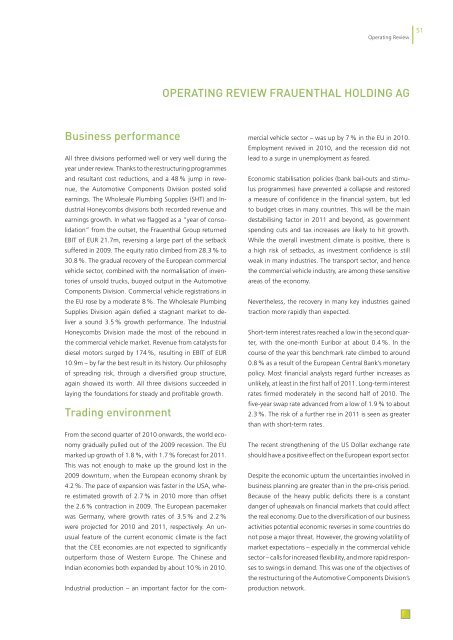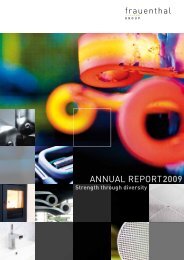Annual Report 2010 - Frauenthal Holding AG
Annual Report 2010 - Frauenthal Holding AG
Annual Report 2010 - Frauenthal Holding AG
You also want an ePaper? Increase the reach of your titles
YUMPU automatically turns print PDFs into web optimized ePapers that Google loves.
Business performance<br />
All three divisions performed well or very well during the<br />
year under review. Thanks to the restructuring programmes<br />
and resultant cost reductions, and a 48 % jump in revenue,<br />
the Automotive Components Division posted solid<br />
earnings. The Wholesale Plumbing Supplies (SHT) and Industrial<br />
Honeycombs divisions both recorded revenue and<br />
earnings growth. In what we flagged as a “year of consolidation”<br />
from the outset, the <strong>Frauenthal</strong> Group returned<br />
EBIT of EUR 21.7m, reversing a large part of the setback<br />
suffered in 2009. The equity ratio climbed from 28.3 % to<br />
30.8 %. The gradual recovery of the European commercial<br />
vehicle sector, combined with the normalisation of inventories<br />
of unsold trucks, buoyed output in the Automotive<br />
Components Division. Commercial vehicle registrations in<br />
the EU rose by a moderate 8 %. The Wholesale Plumbing<br />
Supplies Division again defied a stagnant market to deliver<br />
a sound 3.5 % growth performance. The Industrial<br />
Honeycombs Division made the most of the rebound in<br />
the commercial vehicle market. Revenue from catalysts for<br />
diesel motors surged by 174 %, resulting in EBIT of EUR<br />
10.9m – by far the best result in its history. Our philosophy<br />
of spreading risk, through a diversified group structure,<br />
again showed its worth. All three divisions succeeded in<br />
laying the foundations for steady and profitable growth.<br />
trading environment<br />
From the second quarter of <strong>2010</strong> onwards, the world economy<br />
gradually pulled out of the 2009 recession. The EU<br />
marked up growth of 1.8 %, with 1.7 % forecast for 2011.<br />
This was not enough to make up the ground lost in the<br />
2009 downturn, when the European economy shrank by<br />
4.2 %. The pace of expansion was faster in the USA, where<br />
estimated growth of 2.7 % in <strong>2010</strong> more than offset<br />
the 2.6 % contraction in 2009. The European pacemaker<br />
was Germany, where growth rates of 3.5 % and 2.2 %<br />
were projected for <strong>2010</strong> and 2011, respectively. An unusual<br />
feature of the current economic climate is the fact<br />
that the CEE economies are not expected to significantly<br />
outperform those of Western Europe. The Chinese and<br />
Indian economies both expanded by about 10 % in <strong>2010</strong>.<br />
Industrial production – an important factor for the com-<br />
Operating Review<br />
oPerating revieW <strong>Frauenthal</strong> holding ag<br />
mercial vehicle sector – was up by 7 % in the EU in <strong>2010</strong>.<br />
Employment revived in <strong>2010</strong>, and the recession did not<br />
lead to a surge in unemployment as feared.<br />
Economic stabilisation policies (bank bail-outs and stimulus<br />
programmes) have prevented a collapse and restored<br />
a measure of confidence in the financial system, but led<br />
to budget crises in many countries. This will be the main<br />
destabilising factor in 2011 and beyond, as government<br />
spending cuts and tax increases are likely to hit growth.<br />
While the overall investment climate is positive, there is<br />
a high risk of setbacks, as investment confidence is still<br />
weak in many industries. The transport sector, and hence<br />
the commercial vehicle industry, are among these sensitive<br />
areas of the economy.<br />
Nevertheless, the recovery in many key industries gained<br />
traction more rapidly than expected.<br />
Short-term interest rates reached a low in the second quarter,<br />
with the one-month Euribor at about 0.4 %. In the<br />
course of the year this benchmark rate climbed to around<br />
0.8 % as a result of the European Central Bank’s monetary<br />
policy. Most financial analysts regard further increases as<br />
unlikely, at least in the first half of 2011. Long-term interest<br />
rates firmed moderately in the second half of <strong>2010</strong>. The<br />
five-year swap rate advanced from a low of 1.9 % to about<br />
2.3 %. The risk of a further rise in 2011 is seen as greater<br />
than with short-term rates.<br />
The recent strengthening of the US Dollar exchange rate<br />
should have a positive effect on the European export sector.<br />
Despite the economic upturn the uncertainties involved in<br />
business planning are greater than in the pre-crisis period.<br />
Because of the heavy public deficits there is a constant<br />
danger of upheavals on financial markets that could affect<br />
the real economy. Due to the diversification of our business<br />
activities potential economic reverses in some countries do<br />
not pose a major threat. However, the growing volatility of<br />
market expectations – especially in the commercial vehicle<br />
sector – calls for increased flexibility, and more rapid responses<br />
to swings in demand. This was one of the objectives of<br />
the restructuring of the Automotive Components Division’s<br />
production network.<br />
51




